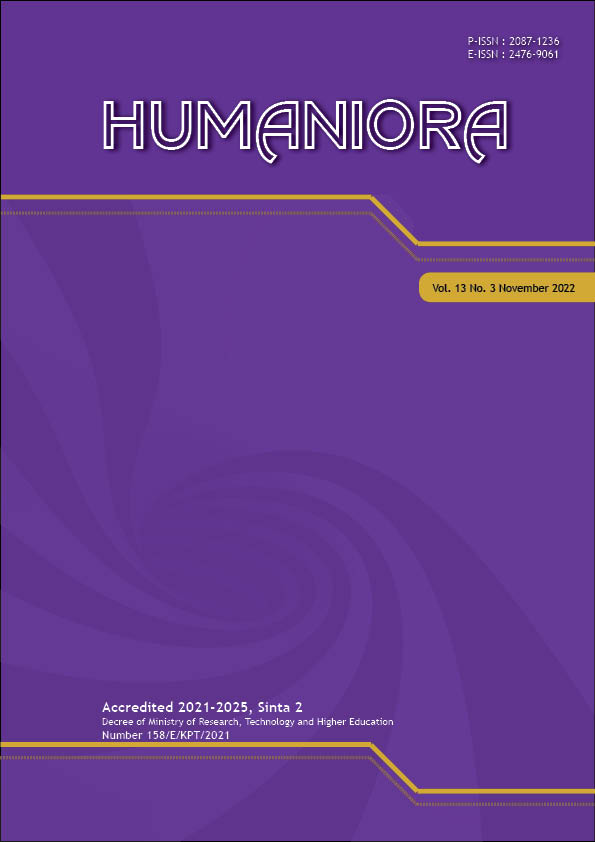Adaptation of Betawi Traditional Music Performers to Preserve Their Existence in a New Normal Era
DOI:
https://doi.org/10.21512/humaniora.v13i3.7966Keywords:
performer adaptation, music performers, Betawi traditional music performersAbstract
The research explored an adaptation to survive in the new normal era in the Jakarta art performers in general and the Betawi traditional music performers in particular. The implementation of social restrictions and regional quarantines in Jakarta had prevented many sectors from making economic activities, including Betawi traditional music performers. The research examined how the Betawi traditional music performers in the Betawi Cultural Village of Setu Babakan adapted to health protocols on stage performance and internet knowledge on virtual performances in the new normal era. Data are taken from in-depth interviews and classified to determine the adaptation ability carried out by Betawi traditional music performers. The Betawi traditional music performance studios were Sanggar Arrominia, Sanggar Gambang Kromong Setia Muda, and Sanggar At-Taubah with certain types of traditional music, such as Gambus, Samrah, Qasidah, Hadrah, and Gambang Kromong. It is found that during the social restriction and regional quarantine in Jakarta, the studios experience a decrease in their request to perform. They need to survive by adapting to the new normal era through the application of the health protocols on stage performance and exploring their knowledge on the internet to conduct the virtual performance. The health protocol limits the flexibility in performing traditional music through mask and face-shield wearing. The average knowledge of the internet and having limited internet devices are some other situations to be adapted by traditional music performers. The adaptation needs to be carried out sometime in the future, and this pandemic only accelerates the need.
References
Badin, A. (2021). Performing arts - How do we survive the pandemic? Revista de Management Comparat International, 22(1), 87-101. http://doi:10.24818/RMCI.2021.1.87.
de Fretes, D., & Listiowati, N. (2020). Pertunjukan musik dalam perspektif ekomusikologi. Promusika, 8(2), 109-122. https://doi.org/10.24821/promusika.v8i2.4636.
Doern, R., Williams, N., & Vorley, T. (2019). Special issue on entrepreneurship and crises: Business as usual? An Introduction and Review of the literature, Entrepreneurship & Regional Development: An International Journal, 31(5-6), 400-412. https://doi.org/10.1080/08985626.2018.1541590.
Fürnkranz, M. (2021). Creative crisis? Performing artists in Vienna’s live music scene in the Age of COVID-19. IASPM Journal, 11(1), 22-37. https://doi.org/10.5429/2079-3871(2021)v11i1.4en.
Mei, C. (2020). Policy style, consistency and the effectiveness of the policy mix in China’s fight against COVID-19. Policy and Society, 39(3), 309-325. https://doi.org/10.1080/14494035.2020.1787627.
Mubarat, (2021). Pelatihan strategi pengembangan kreativitas perupa di era pandemi COVID-19. Abdimas Mahakam Journal, 5(1), 33-41. http://dx.doi.org/10.24903/jam.
Mursalim, K. (2020). Strategi budaya topeng Betawi: Studi Kasus Nyi Meh, Maestro Topeng Betawi. LOA: Jurnal Ketatabahasaan dan Kesusastraan, 15(1), 42-56. https://doi.org/10.26499/loa.v15i1.2335.
Nuriman, H., Sabana, S., Mutiaz, I. R., & Kusmara, R. A. (2020). From real to virtual: Adaptation model of performance arts during Covid-19 period. Jurnal Sosioteknologi, 19(2), 162-169. https://doi.org/10.5614/sostek.itbj.2020.19.2.1.
Roberts, M. (2020). Covid: UK surge in cases an extreme concern. Retrieved from https://www.bbc.com/news/uk-55475240.
Ruastiti, N. M., Sudirga, I. K., & Yudarta, I. G. (2021). Wayang Wong Bali performance in era pandemic Covid 19. IOP Conference Series: Earth Environmental Science, 724, 1-7.
Septiyan, D. D. (2020). Perubahan budaya musik di tengah pandemi Covid-19. Musikolastika: Jurnal Pertunjukan dan Pendidikan Musik, 2(1), 31-38. https://doi.org/10.24036/musikolastika.v2i1.37.
Simanjuntak, D., & Fitriana, R. (2020). Gegar budaya, adaptasi, dan konsep diri sumber daya manusia pariwisata dalam menyongsong era new normal. Society, 8(2), 403-418. https://doi.org/10.33019/society.v8i2.
Spradley, J. P. (1980). Participant observation. Orlando, Florida: Holt, Rinehart and Winston, Inc.
Trisnawati, I. A., & Sulistyani, S. (2021). Performance model and the problems of packaging Balinese dance in the new normal era. Lekesan: Interdisciplinary Journal of Asia Pacific Arts, 4(1), 1-6. https://doi.org/10.31091/lekesan.v4i1.1411.
Walensky, R. P., & del Rio, C. (2020) From mitigation to containment of the COVID-19 pandemic: Putting the SARS-CoV-2 genie back in the bottle. JAMA, 323(19), 1889-1890. https://doi.org/10.1001/jama.2020.6572.
Downloads
Published
How to Cite
Issue
Section
License
Copyright (c) 2022 Iwan Henry Wardhana, Cecep Eka Permana, M Puspitasari, Chotib

This work is licensed under a Creative Commons Attribution-ShareAlike 4.0 International License.
Authors who publish with this journal agree to the following terms:
a. Authors retain copyright and grant the journal right of first publication with the work simultaneously licensed under a Creative Commons Attribution License - Share Alike that allows others to share the work with an acknowledgment of the work's authorship and initial publication in this journal.
b. Authors are able to enter into separate, additional contractual arrangements for the non-exclusive distribution of the journal's published version of the work (e.g., post it to an institutional repository or publish it in a book), with an acknowledgment of its initial publication in this journal.
c. Authors are permitted and encouraged to post their work online (e.g., in institutional repositories or on their website) prior to and during the submission process, as it can lead to productive exchanges, as well as earlier and greater citation of published work.
USER RIGHTS
All articles published Open Access will be immediately and permanently free for everyone to read and download. We are continuously working with our author communities to select the best choice of license options, currently being defined for this journal as follows: Creative Commons Attribution-Share Alike (CC BY-SA)


















